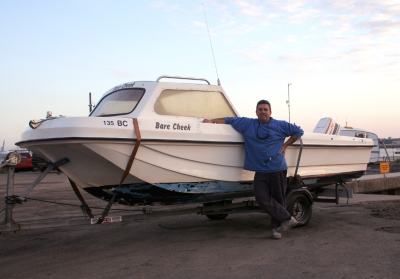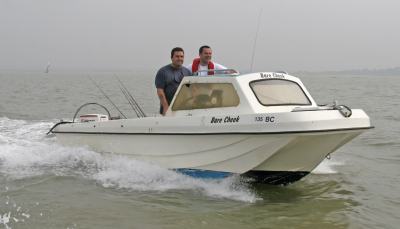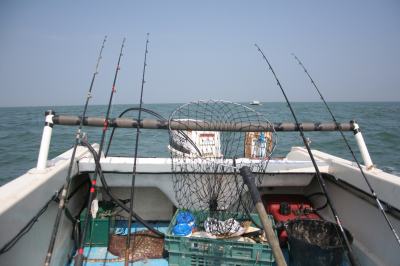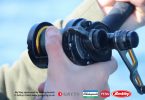Introduction
When I was younger, I spent quite a few years as a ski boat driver in a variety of locations. During that time, I drove many different types of boat, under a multitude of conditions, from tournament ski boats on sheltered lakes, to out and out speedboats on the sea. Being young, and not owning the boats I drove, I often pushed them to their limits, and sometimes beyond! Apart from the immense enjoyment I got from it, I also built up a good knowledge of different types of hull and their characteristics under different conditions. This has taught me to be very particular when parting with my own cash for a boat. What I learnt at the expense of my employers in the past has saved me a small fortune in later life, as well as ensuring that I’ve had a fair few days of good angling along the way!
Buying a small fishing boat these days is a bit of a minefield. With so many to choose from, and every manufacturer claiming that theirs is the answer to all your prayers, how do you choose the one that is perfect for you? The truth is, there’s no such thing as the perfect small fishing boat. Since buying my first one almost 30 years ago, I’ve owned several different types over the years and, after chopping and changing between displacement and planing hulls, never found my ideal boat. All of them offer a compromise of some sort or another. You just have to decide what is important to you, and go for the boat that offers most of what you need. I wanted a fast, safe boat that offered maximum fishing space. It had to be a good, practical fishing boat and just as at home in very shallow inshore waters, as over deep offshore marks. It also had to provide good value for money. After weighing up the pros and cons, and following an extensive sea trial, four years ago, I bought a second hand 17ft Wilson Flyer.

Bare Cheek – my 17ft Wilson Flyer
Stability
The Wilson Flyer is a cathedral hull dory, and is therefore about the most stable fishing platform that you can get. So stable, that you can walk around on the spacious deck, and the boat hardly moves at all. Whilst fishing on the drift, which the Wilson does very well, I’ve often had three men standing down one side of my boat and it doesn’t tip more than a few inches. At anchor they hold well in the tide without skating around and, even in quite rough seas, there is no lateral rolling whatsoever. The only down side is, they are prone to a bit of hull slap, or so I’ve heard. In my own experience though, you only get this in certain conditions, i.e, in a short, choppy sea when the waves are a certain height, and coming at you from a certain angle. Even then, I don’t think it’s much worse than you get from most other small fibreglass fishing boats.
Performance
Another benefit of this hull design is that you get a fantastic performance to horsepower ratio. The Flyer will plane at just over 10 knots with two men and all their fishing gear on board. I have an old 55 horsepower two stroke Johnson outboard on the back of mine, and that can push me along at over 22 knots with a full load up. At that speed it costs me just under a pound per nautical mile in fuel. If I throttle back a touch and cruise at a comfortable 15 to 17 knots, those figures are improved quite a bit. With a 50 horsepower four stroke on the back, the Wilson would probably be one of the most economical boats you could run. Although a fast boat design, it also performs very well at displacement speeds, slipping effortlessly across the water rather than dragging through it. My 6 horsepower auxiliary engine gives an average speed of 5 knots, which isn’t bad at all.
Handling
Underway, the ride is solid and predictable with no surprises or little quirks to catch you out. This is in no small part down to the excellent lateral stability, which is maintained at speed. The hull is also surprisingly responsive and will hold tight turns along with the best of them. You can be quite bold when heading into choppy waters, and the boat will take far more punishment than you can. In all but the very worst conditions, (when you really shouldn’t be out there anyway), there is no need to drop below planing speeds in the Wilson. Under normal conditions the ride is very dry, but in very choppy seas you may get some spray coming back at you over the top of the cabin. Even under those conditions, I’ve found the amount of water drained out of the drain plug at the end of the day has been minimal, and I’ve never had to operate the bilge pump to empty water taken on board whilst underway. There is a top screen available for the cabin, but I’ve never felt the need to consider buying one. I’ve heard that dories slam when heading into rough seas, but I’ve never found it to be a problem. In moderate seas, you can soften the ride considerably just by throttling back a touch when necessary and, if available, proper use of power trim would achieve an even more comfortable ride.
Fishing
With a beam of 6ft, the 17ft version gives me 25 square feet under the cabin in which I store all my safety gear, anchor chain and line, auxiliary engine, spare fuel, and all my fishing gear. Forward of the cabin, under the foredeck, there is a locker where I store my spare anchor, chain and line. That leaves me 40 square feet of totally uncluttered deck space for fishing, and that’s not including the space under the outboard well where I store my main fuel tank and battery. That’s a serious amount of fishing space for a 17ft boat. I’ve been on bigger boats that look great when they are empty, but once you load them up with everything you need for a day’s fishing, they seem to shrink considerably. Freeboard on the Wilson Flyer is 26 inches amidships which, although enough to allow safe movement around the deck, can be further improved by fitting stainless safety rails. Even when fully loaded, there is still enough room for two anglers to fish two or three rods each in complete comfort. I regularly fish three people without any problems and, although it gets a bit cosy, I have even accommodated four on a few occasions. Two people can saltwater fly fish from my boat without getting in each other’s way. At anchor the boat behaves as well as you would expect from one twice the size. On the drift, she will hold a steady and true line without turning, or spinning, in the tide.
Conclusion
For a small, trailable fishing boat, I don’t think the Wilson Flyer can be beaten for the price. As I said before, there’s no such thing as the perfect small fishing boat, it’s all about making compromises. When I look at what the Wilson Flyer has to offer in the way of deck space, stability, speed and safety, the benefits far outweigh any negative points; like a bit of hull slap at anchor, which, to explode another myth, definitely doesn’t have a detrimental effect on catch rates! I have been in small fishing boats that are a smoother ride when underway in rough seas, but they’ve been absolutely horrible to fish from in anything other than flat calm conditions. The Wilson Flyer doesn’t have that small boat feel. It feels like you’re fishing from a big boat. I bought my boat secondhand and she is over 20 years old now, which is testimony to the build quality of Wilson boats. I’ve given her a hammering and she’s looking a bit tired now. So, this winter I’m going to give her a new deck, fit new windows, and glass in some new lockers under the cabin along with a new steering consul. I’m also getting to the age where I would like to be able to walk onto, and off of, my boat instead of towing, launching and recovering every time I go fishing, so I’m looking at getting something a bit bigger, and a mooring to keep it on. Wilson does a 20, a 23 and a 24-foot version of the Flyer, and they all represent tremendous value for money. I don’t think I’ll have to look further than any of those models to satisfy my needs. Having said that, I really like my boat; and once the work is done, she’ll be good for another 20 odd years and I know I’ll be tempted to keep her!
Pricing & Contact Details
I recently contacted Wilson for an up to date brochure and I think that many boat anglers will be pleasantly surprised at how much a basic boat costs. For example, the 17ft Wilson Flyer was £2,800 and the 23ft Wilson Flyer was £5,500. This wasn’t just for a bare hull, but for a boat that, basically, just needed an engine and your electrics fitting before she’s ready to go!
There doesn’t appear to be a website for Wilson Boats, but you can contact them on 023 9247 3920.
Their address is:
Brian Wilson Glassfibre Dinghies
The Bungalow
26 Scratchface Lane
Bedhampton
Havant
Hampshire
PO9 3NG
The Video Below Shows A Wilson Flyer On The Water










